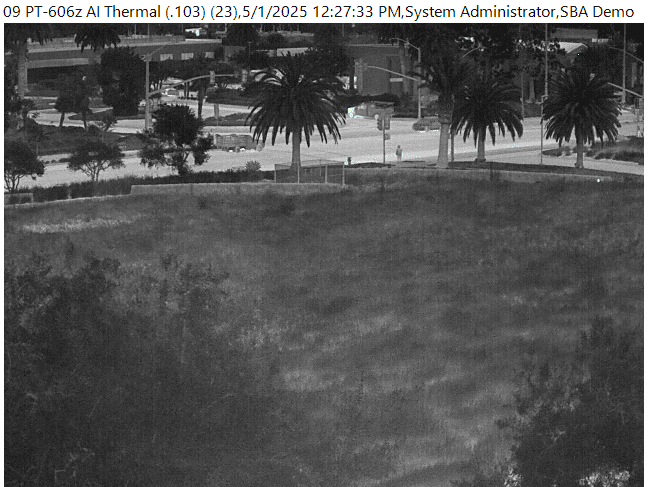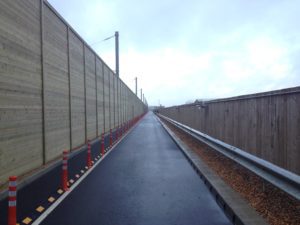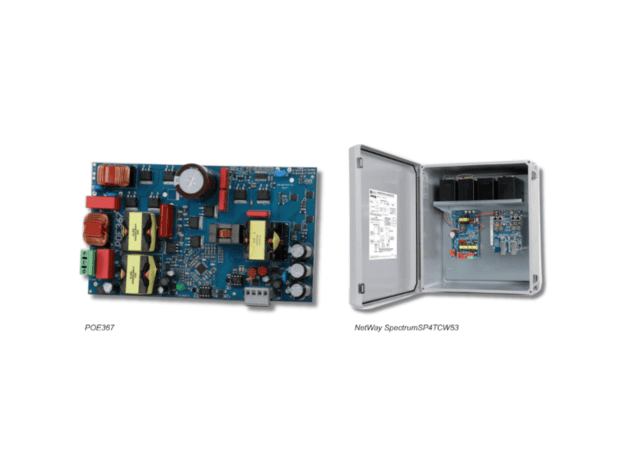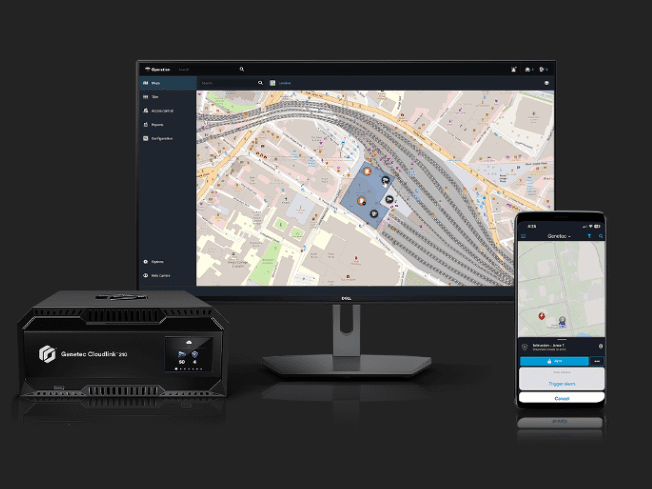Recent research identifies new challenges that are facing perimeter protection for transport infrastructure, focusing primarily on railways – sponsored by HERAS
As treasury money begins to transform vital transit networks, it’s hoped pressure on our roads, railways, and ports will begin to ease. The UK is beginning to return to some kind of normality, quickly followed by the rest of the world, as a result, our urban centres are bustling, and transport infrastructure is back in high demand.
Unfortunately, the busier these services become, the greater the security and safety risks are for the surrounding areas. Fortunately, there is a broad range of options available to those responsible for assessing and reducing these risks.
“With this in mind, it’s even more important that transport security and perimeter safety are being carefully considered from the very beginning of each project”
It is brilliant to see that this focus on supporting and improving the lives of the local communities is being supported by the Government at both national and local levels, via the Government’s Build Back Better: Our Plan for Growth strategy, published in March 2021. This focuses on stimulating growth through infrastructure, skills, and innovation, and the Department for Transport’s record investment, worth £100bn next year, for roads, rail, ports, transport hubs, and cities will be gratefully welcomed by those responsible for the further development of this infrastructure.
It is clear the focus is on broad and rapid expansion. With this in mind, it’s even more important that transport security and perimeter safety are being carefully considered from the very beginning of each project. Peter Jackson, Managing Director of Jacksons Fencing explores exclusively for Security Buyer how perimeter protection solutions can help protect transport infrastructure, focusing on railway.
Knowledge is power
Jacksons Fencing recently commissioned research across the UK rail engineering sector, the findings highlighted that 68% of respondents felt there were gaps where far more could be done to help rail engineer professionals understand current standards associated with railway perimeter safety. When we spoke to engineers specifically, they stressed that a more open dialogue with product manufacturers, easier access to product specification and increased inspection measures were all factors that would help to improve the implementation process.
Crime is creeping up
During the many months of lockdown, it was reported that crime rates dropped by 8%, however, now that the restrictions have eased, potential physical threats on the frontline of railways, motorways and port facilities should be reassessed to check they’re robust enough to prevent the most common threats to railway safety. According to our report, the two biggest threats to railway safety are ‘vandalism’ and ‘trespassers with criminal intent’. As lockdown measures eased, multiple counties across the country saw vandalism, theft and anti-social behaviour rise significantly. With extensive railway projects such as HS2 and Crossrail gathering momentum, preventative measures to minimise the risk of accidents and criminal incidents must be considered carefully by the engineers responsible for these designs, from the very beginning of the project.
No two sites are the same and perimeters need to be designed to suit the specific needs of each project, to deter malicious and life-threatening attacks on those using these extended transit routes. Issues including end-user safety, emergency access, risk management, and pressing environmental concerns, such as increased temperature, unpredictable weather, noise pollution, and animal welfare also need to be taken into account.
Sourcing solutions
Now we’ve explored the threats against transport infrastructure safety, let’s discuss the security solutions that will ensure the transport network is secure, efficient, compliant, and environmentally sound.
Specifying the most appropriate type of barrier is an important decision for industry professionals working on transport infrastructure projects. So, what should you be looking out for?
I have broken it down into six key considerations.
More than meets the eye
As with all perimeter security projects, the process should begin with a thorough assessment of the site. This will flag important considerations including the choice of aesthetic and will help decipher the best suited security barriers for the site. Our survey revealed this is not always considered a top priority. However, there is a wide range of products available on the market that look good and still suit the location in question, and, most importantly these options still offer very robust protection.
Compliance
Make a conscious effort to ensure you’re meeting the safety and sustainability compliance requirements. The best suppliers will advise on what’s needed to meet certain standards, so if in doubt, ask the experts.
Economic value
Next, consider the lifetime value of the specified products. Opting for durable and high-quality materials will guarantee longevity, and help mitigate budgetary cost pressures later down the line.. It is also worth doing your research and looking into more innovative products on the market. Tamper-proof panel connectors with fixings on the secure side of the fence provides a simple solution that is often overlooked.
Investing in the longevity of the chosen security fencing will also save money on costly repairs and deterioration in the long term. It is essential that ongoing maintenance of fencing and gates is regular and thorough, particularly in the cooler months. You’ll find that certain materials and fixings are easier to maintain than others.
Polyester powder coating is recommended over traditional paint. This will ensure the coating doesn’t chip or crack and will keep its glossy finish. A galvanised or zinc alloy-coated steel will provide similar protection against the elements particularly from corrosion or rust, and guarantee durability.
If budgets are tight, cost savings can be made by avoiding specifying higher security fencing than is needed for the site. Remember that opting for fencing without a guarantee may save some money initially, but will incur costs and require replacing far sooner than fencing with a longer guarantee.
An integrated approach
We often refer to an integrated approach to security, and combining perimeter fencing with additional surveillance and alarm technology where required will help achieve this. Systems combining security fencing with CCTV cameras, and anti-intrusion detection alarms and monitors are available.
Perimeter fencing will only ever enhance a security strategy, and when specified correctly, alongside electronic security systems, it will create a robust level of physical protection, making the site far less appealing to intruders.
Seek expert advice
Consulting with manufacturers will aid a full understanding of the solutions that are available. We advise investing time in making use of suppliers’ website information, product videos, NBS Source, and expert advice.
A tick box exercise
If you decide to specify a ‘tested and certified’ fence, gate, or barrier for a transport site it’s imperative that you follow this checklist:
- Obtain proof of certification from your supplier
- Be sure of your fencing’s suitability to site-specific ground conditions
- Check specifications to ensure effectiveness against specific threats
- Specify appropriate coatings especially for use in corrosive atmospheres
- Installation in accordance with manufacturer’s specifications
- Regular testing and inspections for condition, damage,and operation
- Regular maintenance to prevent premature degrading
A team effort
Although high security barriers require a higher initial investment, they will provide a far greater level of protection of the infrastructure, passengers, and the general public from harm. It is important that there continues to be an investment in the learning and development of key industry stakeholders, and furthering research will help to bring specifiers up to speed with wider issues including sustainability and compliance with industry standards. Reputable suppliers are ready and willing to assist, by sharing in-depth knowledge of what the latest security products can achieve, and working to tailor solutions to unique project needs and cost projections.
With improved guidance, industry professionals can gain a better appreciation of the transport security agenda and the benefits that high security barriers have on society. It is my hope that the industry will take these steps to help do and be better. The last 18 months has shown how fragile and uncertain the world is, and there has never been a better time to implement change to ensure those who rely on this transport infrastructure are kept safe.
Sponsored by HERAS
“Listening” fences and “talking” gates
The next generation of perimeter intrusion innovations are just part of the complete perimeter security product portfolio from Heras
Heras recently launched two ground-breaking innovations that strengthen the company’s position as Europe’s end-to-end supplier of permanent and mobile perimeter protection solutions.
Its next-generation perimeter intrusion detection systems (PIDSs) were some of the star attractions at the recent International Security Expo (ISE) at London’s Olympia – and journalists who came onto the Heras stand to see the fence aspect dubbed it the “listening” fence.
That’s because GeoMic uses a discreet microphonic sensor cable (alpha) that listens for sounds – such as those generated from an intrusion attempt – around the entire perimeter. It is accompanied by another product, GeoPoint, which is a sensor system that utilises multiple sensors distributed along the fence line to detect movement and vibration. These PIDSs are designed to complement and greatly increase the overall effectiveness of both existing and newly specified perimeter protection fence and gate lines.
Heras Product Manager (Detection) Steve Dobby said that the ISE was a great platform to showcase PIDSs and demonstrate their capabilities.
“Behind the scenes at Heras, we’ve been working hard to develop the next generation of PIDSs, and we’re delighted that they were so well received by the visitors and journalists who came to see them,” said Steve. “It’s understandable that the listening capabilities of GeoMic grabbed the headlines, but PIDSs are so much more than that: they provide greater levels of perimeter protection for high-security sites (such as infrastructure of national or strategic importance) and sites such as distribution hubs and data centres.
“Our entire portfolio of perimeter protection solutions and services – including demarcation, entrance control, detection and integrated systems, as well as our maintenance services – are designed to integrate seamlessly and harmoniously to ensure the site is completely secure.”
It’s a sentiment echoed by Oliver Cook, Heras’s Regional Service Sales Manager (North), who has been part of the team spearheading the maintenance message with the launch of Connect – a smart new servicing and maintenance solution.
Connect is a cloud-based portal that offers real-time insights into the status of an entrance control system, including swing, sliding and bi-fold gates, with remote monitoring of user access and automatic alerts and notifications via smartphone, tablet or PC. It also enables users to open access systems via mobile phone, as well as enables Heras to provide remote and proactive monitoring of the systems.
“Connect is a game-changer, as it provides information about the status of entrance solutions provided by both Heras and other suppliers. It monitors all key components 24/7 and translates this monitoring into practical information for facilities managers,” said Oliver.
“Customers like the fact that all the key components in the Connect system ‘talk’ to each other, and the system also integrates with our Essential, Premium and Premium VIP support levels.”
He added: “We’re still in the process of formally rolling out Connect, but everyone we’re showing it to is changing their stance on servicing and maintenance: instead of seeing them as an afterthought, they’re viewing them as the lynchpin of a site’s perimeter protection and entrance control strategy.”
To learn more about Heras’s demarcation, entrance control, detection and integrated systems and maintenance services, visit www.heras.co.uk
Commentary: Peter Jackson, Managing Director of Jacksons Fencing
Jacksons Fencing recently commissioned research across the UK rail engineering sector, the findings highlighted that 68% of respondents felt there were gaps where far more could be done to help rail engineer professionals understand current standards associated with railway perimeter safety. When we spoke to engineers specifically, they stressed that a more open dialogue with product manufacturers, easier access to product specification and increased inspection measures were all factors that would help to improve the implementation process.

During the many months of lockdown, it was reported that crime rates dropped by 8%, however, now that the restrictions have eased, potential physical threats on the frontline of railways, motorways and port facilities should be reassessed to check they’re robust enough to prevent the most common threats to railway safety. According to our report, the two biggest threats to railway safety are ‘vandalism’ and ‘trespassers with criminal intent’. As lockdown measures eased, multiple counties across the country saw vandalism, theft and anti-social behaviour rise significantly. With extensive railway projects such as HS2 and Crossrail gathering momentum, preventative measures to minimise the risk of accidents and criminal incidents must be considered carefully by the engineers responsible for these designs, from the very beginning of the project.
No two sites are the same and perimeters need to be designed to suit the specific needs of each project, to deter malicious and life-threatening attacks on those using these extended transit routes. Issues including end-user safety, emergency access, risk management, and pressing environmental concerns, such as increased temperature, unpredictable weather, noise pollution, and animal welfare also need to be taken into account.
Commentary: Dave Solly, Product Manager for Perimeter at Gallagher
Adaptive Thresholds allows a Fence Controller to dynamically adapt to the local conditions. It achieves this by adapting the alarm threshold at a percentage of the return voltage so that when a gradual voltage drop occurs due to environmental conditions, the threshold will adapt with it so that it will not trigger an alarm.

We’re so thrilled to see Adaptive Thresholds recognised by the New Zealand Security Association. This feature truly represents Gallagher’s ability to create innovative solutions to genuine security challenges. Businesses do not want to constantly respond to false alarms that are meaningless, as it costs money and can cause alarm fatigue – running the risk of operators not responding to real alarms when they should.
This feature was developed in response to a site in the Middle East that was receiving regular false alarms due to current leakage. Due to the location of this site, the salt build-up on the fence line mixed with the high levels of humidity makes insulating surfaces conductive, which leads to a loss of voltage on the Monitored Pulse Fence, creating a false alarm.
Adaptive Thresholds is designed to seamlessly adapt to changing environmental conditions – allowing a site to change from a fixed alarm threshold to a dynamic threshold. Adaptive Thresholds is one example of how Gallagher is helping correctional facilities, critical infrastructure and other high-risk sites, minimise environmental factors that impact the performance of their essential perimeter security, while remaining as sensitive as possible to tampering on the fence line.
Understanding just how critical this feature is for organisations around the world, Gallagher has made Adaptive Thresholds available in Command Centre from version 8.40 onwards.
To stay up to date on the latest, trends, innovations, people news and company updates within the global security market please register to receive our newsletter here.
Media contact
Rebecca Morpeth Spayne,
Editor, Security Portfolio
Tel: +44 (0) 1622 823 922
Email: [email protected]



























